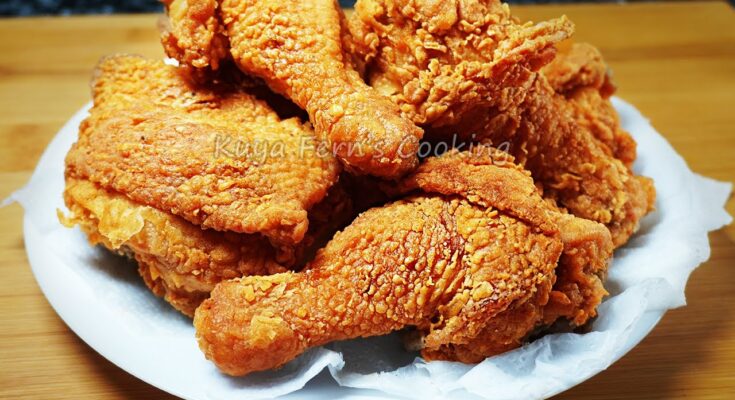Fried Chicken Legs Recipe: There’s something irresistibly satisfying about biting into a piece of perfectly fried chicken. The crispy, golden-brown crust, the juicy, flavorful meat—fried chicken is more than just food; it’s comfort on a plate. And when it comes to fried chicken, legs are where it’s at. Whether you’re cooking for a family dinner, a weekend get-together, or just treating yourself to something delicious, fried chicken legs hit the spot every time.
In this article, you’ll get a step-by-step breakdown of how to make fried chicken legs that are crispy on the outside, juicy on the inside, and packed with flavor. You’ll also find tips, tricks, and helpful hints to make your chicken the best it can be. Let’s get into it—because trust me, once you’ve made these, you’ll never want takeout fried chicken again.
Why Fried Chicken Legs Are a Classic Favorite
Fried chicken legs have earned their spot as a comfort food staple for good reason. First off, they’re incredibly flavorful. The dark meat of the leg and thigh is juicier than the breast, making it the perfect cut for frying. When done right, the result is a beautiful contrast of textures: crispy skin and tender meat that practically falls off the bone.
They’re also budget-friendly and super versatile. You can season them in a million different ways—from Southern-style buttermilk fried to spicy Nashville hot. And let’s not forget the sheer nostalgia factor. For many of us, fried chicken legs bring back memories of family gatherings, summer picnics, and Sunday dinners.
Plus, chicken legs are forgiving. Unlike chicken breasts, which can dry out easily, legs stay moist even if you slightly overcook them. That’s why they’re a great starting point for anyone new to frying chicken at home.
What Makes This Recipe So Good
So, what sets this fried chicken legs recipe apart from the rest? It’s all in the method. We’re going beyond just dunking chicken in flour and tossing it in hot oil. This recipe involves:
- A flavorful marinade that penetrates deep into the meat.
- A seasoned flour coating that crisps up beautifully.
- Proper frying technique to ensure even cooking and that crave-worthy crunch.
The goal here is balance. You want each bite to be juicy, crispy, and bursting with flavor. With this recipe, you’ll get all that—and maybe even a little more. It’s been crafted to be beginner-friendly, yet impressive enough for experienced home cooks.
Choosing the Right Chicken Legs
When it comes to fried chicken, the cut matters. Chicken legs (drumsticks) are ideal for frying because of their size, flavor, and ease of handling. But not all chicken legs are created equal. Here’s what to consider when buying them:
Fresh vs. Frozen
- Fresh chicken legs are preferred for frying. They cook more evenly and retain more moisture.
- Frozen chicken legs are fine too—but make sure they’re completely thawed before frying. Frying partially frozen chicken is dangerous and leads to uneven cooking.
Skin-On vs. Skinless
- Skin-on chicken legs are essential if you want that crispy, golden exterior. The skin helps protect the meat and adds flavor.
- Skinless legs can still be fried, but the texture will be different and may not be as crispy.
Whenever possible, opt for organic or free-range chicken. The meat tends to be more flavorful and tender—totally worth the extra few bucks.
Essential Ingredients You’ll Need
Before we get into the actual cooking process, let’s talk ingredients. You don’t need a huge list of fancy items—just a few key staples from your pantry can create that legendary fried chicken flavor.
Spices and Seasonings
Here’s a basic seasoning blend you can use:
- Salt
- Black pepper
- Garlic powder
- Onion powder
- Paprika (smoked or sweet)
- Cayenne pepper (optional, for heat)
- Dried herbs (thyme, oregano, or Italian seasoning)
Feel free to tweak it to your taste!
Wet Ingredients
- Buttermilk – Classic for marinating. It tenderizes and adds flavor.
- Eggs – Help the coating stick to the chicken.
Dry Ingredients
- All-purpose flour – The base of the breading.
- Cornstarch – Adds extra crispiness.
- Baking powder – Helps puff up the crust for extra crunch.
Mix your dry ingredients with a bit of the spice blend to season every layer.
Tools and Equipment Needed
You don’t need a deep fryer to make killer fried chicken. Here’s what you’ll need:
- Large mixing bowls (for marinating and breading)
- Tongs (for safe handling)
- Thermometer (to monitor oil temperature)
- Heavy-duty skillet or Dutch oven
- Wire rack (to drain and keep the chicken crispy)
- Paper towels (for excess oil)
These tools help keep things clean, safe, and consistent.
Step-by-Step Guide to Making Fried Chicken Legs
Ready to fry? Let’s break it down step-by-step.
1. Cleaning and Prepping the Chicken
Start by rinsing your chicken legs under cold water and patting them dry with paper towels. Trim off any excess fat or skin, but don’t remove all the skin—you want that for crispiness!
2. Marinating the Chicken (Optional but Recommended)
Place the chicken in a bowl or zip-top bag. Add buttermilk and half your seasoning mix. Let it sit for at least 2 hours—overnight is best. This step helps tenderize the meat and infuse it with flavor.
3. Setting Up a Breading Station
Get two shallow bowls:
- One for eggs (beat them with a splash of milk or water)
- One for dry mix (flour, cornstarch, baking powder, and remaining seasonings)
Line them up in an assembly line—chicken, egg wash, flour mix, and a clean plate for the breaded pieces.
4. Dredging the Chicken Properly
Take each piece of marinated chicken and dip it in the egg wash, then press it into the flour mix. Make sure it’s fully coated. Press the flour in with your hands to create a thick, textured crust.
Pro tip: Double dredge for extra crunch—egg, flour, repeat.
5. Resting the Chicken Before Frying
After breading, let the chicken rest on a wire rack for about 10–15 minutes. This helps the coating stick better during frying and prevents it from falling off.
6. Heating the Oil
Pour oil into a deep skillet or Dutch oven to about 2–3 inches deep. Heat it to 350°F (175°C). Use a thermometer—guessing doesn’t cut it.
Don’t overcrowd the pan! Fry in batches if needed.
7. Frying to Golden Perfection
Carefully lower the chicken legs into the hot oil. Fry for 12–15 minutes, turning occasionally, until they’re golden brown and crispy.
The internal temperature should reach 165°F (74°C).
8. Draining Excess Oil the Right Way
Once cooked, place the chicken on a wire rack over a baking sheet. This allows air to circulate and keeps the crust crispy. Don’t place it directly on paper towels—it traps steam and softens the crust.
How to Tell When Chicken Legs Are Fully Cooked
Getting your fried chicken legs perfectly cooked isn’t just about a crispy coating—it’s about making sure the inside is juicy and safe to eat. Undercooked chicken can be dangerous, while overcooked chicken ends up dry and chewy. So how do you nail it every time?
1. Use a Meat Thermometer
The most reliable way to check if your chicken is done is with a meat thermometer. Insert it into the thickest part of the leg (without touching the bone). You’re aiming for an internal temperature of 165°F (74°C). Anything lower and it’s undercooked; higher than 175°F and you risk drying it out.
2. Visual Cues
If you don’t have a thermometer, slice into the thickest part of one drumstick:
- The juices should run clear, not pink or red.
- The meat should be opaque white or light brown, not translucent.
- The crust should be golden brown and crisp.
3. Feel the Texture
Gently press the chicken with tongs. Cooked chicken should feel firm but not hard. If it’s still squishy, it likely needs more time.
Take your time with this step—it’s better to be sure than sorry!
Oven-Fried Alternative (Healthier Version)
Trying to cut down on oil but still want that satisfying crunch? The oven has your back. You can still get a crispy, golden crust without deep frying. Here’s how:
Steps for Oven-Fried Chicken Legs
- Preheat your oven to 425°F (220°C).
- Line a baking sheet with parchment paper or foil, and place a wire rack on top.
- Coat the chicken in the same way as the fried version (buttermilk marinade, egg wash, seasoned flour).
- Spray each leg generously with cooking spray or brush lightly with oil. This helps mimic the frying effect.
- Bake for 40–45 minutes, turning halfway through to ensure even crisping.
Tips for Best Results
- Use panko breadcrumbs mixed with flour for extra crunch.
- Let the chicken rest after breading, just like the fried version.
- Finish with a broil for 2–3 minutes if you want that ultra-crispy top.
This version isn’t just healthier—it’s also less messy and more hands-off. Great for busy nights!
Common Mistakes to Avoid
Even seasoned cooks make mistakes when frying chicken. Here are some of the biggest pitfalls—and how to avoid them:
1. Skipping the Rest Time
Don’t rush from breading to frying. Letting your chicken rest before hitting the oil helps the coating stick better and fry more evenly.
2. Frying Cold Chicken
Let your marinated chicken come to room temperature for about 30 minutes before cooking. Frying cold chicken can drop the oil temp, resulting in soggy, greasy crusts.
3. Overcrowding the Pan
This is a big one. Too many chicken pieces in the oil at once lowers the temperature and causes uneven cooking. Fry in small batches for consistent, crispy results.
4. Using the Wrong Oil
Stick with neutral oils that have high smoke points, like canola, vegetable, peanut, or sunflower oil. Avoid olive oil or butter—they burn too easily.
5. Not Monitoring Oil Temperature
If your oil isn’t hot enough, the chicken absorbs too much oil. Too hot, and the outside burns before the inside cooks. Use a thermometer and keep it around 350°F throughout.
Avoiding these mistakes can be the difference between soggy disappointment and crispy perfection.
Serving Suggestions
Fried chicken legs are incredibly versatile, and the right sides can turn them into a complete, crowd-pleasing meal. Whether you want something indulgent or light, here are some top pairings:
Classic Comfort Food Sides
- Mashed Potatoes with Gravy
- Macaroni and Cheese
- Cornbread or Biscuits
- Creamy Coleslaw
- Southern-style Green Beans
Fresh and Light Options
- Garden Salad with Lemon Vinaigrette
- Grilled Veggies
- Cucumber and Tomato Salad
- Steamed Broccoli or Asparagus
Dipping Sauces
Don’t forget the sauce! Here are a few must-tries:
- Honey Mustard
- Ranch Dressing
- Hot Sauce (like Frank’s or Cholula)
- BBQ Sauce
- Garlic Aioli
Mix and match to suit your mood—or serve a few and let everyone choose their favorite.
Storing and Reheating Leftover Fried Chicken
Leftovers? Lucky you! Fried chicken legs can be just as tasty the next day—if you reheat them the right way.
Storing Fried Chicken
- Refrigerator: Store in an airtight container or wrap tightly in foil. Good for up to 3–4 days.
- Freezer: Wrap in foil and place in freezer bags. Can last up to 3 months.
Best Reheating Methods
Oven Method (Best for Crispy Texture):
- Preheat to 375°F (190°C).
- Place chicken on a wire rack over a baking sheet.
- Bake for 15–20 minutes, until hot and crispy.
Air Fryer Method:
- Set to 375°F.
- Air fry for 5–7 minutes.
Microwave (Not Recommended):
- Use only for quick reheating.
- Chicken may turn soggy.
For best results, let the chicken come to room temperature before reheating—it’ll warm more evenly.
Tips for Extra Crispy Chicken Every Time
Want that satisfying, restaurant-style crunch? These tips will take your fried chicken game to the next level.
1. Use Cornstarch in Your Breading Mix
Flour alone can get you crispy, but adding a few tablespoons of cornstarch makes the crust lighter and crunchier.
2. Double Dredge for Crunch
Dip the chicken in the egg and flour twice. This gives it a thicker crust that holds up better during frying.
3. Let the Coated Chicken Rest
After breading, let your chicken rest for 10–15 minutes. This gives the coating time to bind to the chicken.
4. Keep Oil at a Steady Temperature
Fluctuating oil temps lead to uneven frying. Monitor it constantly and adjust the heat as needed.
5. Don’t Cover After Frying
Covering hot fried chicken traps steam and makes it soggy. Always let it rest on a rack with good airflow.
These small changes can turn good fried chicken into great fried chicken.
FAQs about Fried Chicken Legs Recipe
1. How long should I marinate chicken legs before frying?
Ideally, marinate for at least 2 hours, but overnight is best. This gives the flavors time to develop and tenderizes the meat.
2. Can I use an air fryer instead of deep frying?
Absolutely! Air frying is a healthier alternative and still gets the chicken crispy. Just adjust the temperature to 375°F and cook for about 25–30 minutes, flipping halfway.
3. What oil is best for frying chicken legs?
Go for oils with high smoke points like canola, peanut, vegetable, or sunflower oil. Avoid oils like olive oil or butter which can burn at high temps.
4. How do I keep the breading from falling off?
Let the chicken rest after dredging for 10–15 minutes, and don’t overcrowd the pan. This helps the coating adhere better during frying.
5. Can I use boneless legs for this recipe?
You can, but bone-in chicken legs stay juicier and more flavorful. Boneless options cook faster, so adjust your frying time accordingly.
Conclusion
There you have it—a complete, foolproof guide to making the ultimate fried chicken legs at home. Crispy on the outside, juicy on the inside, and seasoned just right. Whether you’re cooking for your family or throwing down in the kitchen for guests, this recipe delivers the kind of finger-licking flavor that’ll have everyone coming back for seconds (and thirds).
From choosing the right chicken to mastering the marinade, dredging, and frying techniques, you’re now armed with everything you need. So heat up that oil, roll up your sleeves, and let’s get frying!



